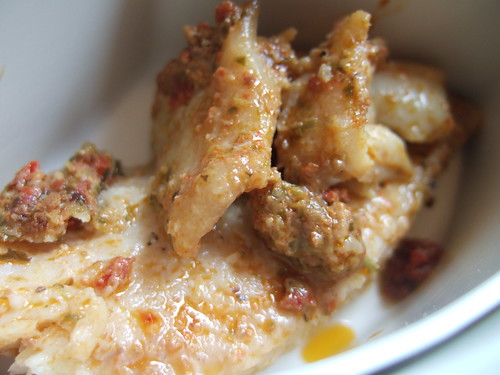From the New York Times last week, I learned what salmoriglio is: an acidic and velvety sauce of Sicilian origin that’s perfect for fish. I always use it; I just never knew it had an actual name!
After running an errand for my friend Judy, I stopped by the Westside Market on Broadway and bought a whole red snapper to prepare for dinner. I’ve been watching the Bahamian fish competition on Discovery Channel and I’ve been craving grilled whole fish for days. But with snow on the ground and without a grill, I had to settle for baked fish safely cooked in the confines of the Dr.’s apartment.
Ingredients:
1 whole red snapper, scaled, cleaned, pat dry with paper towels
2 sprigs rosemary
1 lemon, sliced
1 red onion, sliced
6 bay leaves
4 garlic cloves, peeled, minced
oil, salt, pepperFor the salmoriglio:
leaves from 2 sprigs of thyme, stems reserved for fish
2 sprigs of parsley, chopped
1 tsp oregano powder
1 garlic cloves, minced
zest and juice from 1 lemon
oil, salt, pepper1. In a bowl, mix the salmoriglio herbs and spices together. Drizzle some oil and add the lemon juice by whisking with a fork. Cover and refrigerate until ready to serve.
2. Meanwhile, preheat the oven to 450º. Line a baking sheet with aluminum foil and brush with olive oil.
3. Scatter the half of the lemon slices and half of the onion on the baking sheet and top with the thyme stems, rosemary sprigs and bay leaves. Season the fish with salt and pepper and stuff with garlic cloves and place on top of the herbs. Drizzle the fish with olive oil. Place the remaining lemon and onion slices on top of the fish. Cover with foil and bake until the fish is cooked through, about 20 minutes. Serve the fish whole, with salmoriglio sauce on the side.
Related post/s:
Poisson en papillote, or fish in paper, recipe
Buttercup fish with peashoots recipe






